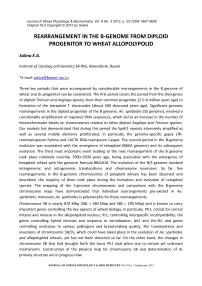Rearrangement in the b-genome from diploid progenitor to wheat allopolypolid
Автор: Salina E.A.
Журнал: Журнал стресс-физиологии и биохимии @jspb
Рубрика: Supplement
Статья в выпуске: 3 т.8, 2012 года.
Бесплатный доступ
Genomic rearrangements, amplification of repeated dna sequences, b genome, chromosome 5b
Короткий адрес: https://sciup.org/14323619
IDR: 14323619
Текст статьи Rearrangement in the b-genome from diploid progenitor to wheat allopolypolid
Original Text Copyright © 2012 by Salina
REARRANGEMENT IN THE B-GENOME FROM DIPLOID PROGENITOR TO WHEAT ALLOPOLYPOLID
Salina E.A.
Institute of Cytology and Genetics SB RAS, Novosibirsk, Russia
Three key periods that were accompanied by considerable rearrangements in the B genome of wheat and its progenitor can be considered. The first period covers the period from the divergence of diploid Triticum and Aegilops species from their common progenitor (2.5–6 million years ago) to formation of the tetraploid T. diccocoides (about 500 thousand years ago). Significant genomic rearrangements in the diploid progenitor of the B genome, Ae. speltoides (SS genome), involved a considerable amplification of repeated DNA sequences, which led to an increase in the number of heterochromatin blocks on chromosomes relative to other diploid Aegilops and Triticum species. Our analysis has demonstrated that during this period the Spelt1 repeats intensively amplified as well as several mobile elements proliferated, in particular, the genome-specific gypsy LTR-retrotransposon Fatima and CACTA DNA-transposon Caspar. The second period in the B-genome evolution was associated with the emergence of tetraploid (BBAA genome) and its subsequent evolution. The third most important event leading to the next rearrangement of the B genome took place relatively recently, 7000–9500 years ago, being associated with the emergence of hexaploid wheat with the genomic formula BBAADD. The evolution of the B/S genome involved intergenomic and intragenomic translocations and chromosome inversions. So far, five rearrangements in the B-genome chromosomes of polyploid wheats has been observed and described; the majority of them took place during the formation and evolution of tetraploid species. The mapping of the S-genome chromosomes and comparison with the B-genome chromosome maps have demonstrated that individual rearrangements pre-existed in Ae. speltoides ; moreover, Ae. speltoides is polymorphic for these rearrangements.
Chromosome 5B is nearly 870 Mbp (5BL = 580 Mbp and 5BS = 290 Mbp) and is known to carry important genes controlling the key aspects of wheat biology, in particular, Ph1 , critical for correct mitosis and meiosis in the allopolyploid nucleus; Kr1 , controlling interspecific incompatibility; the genes controlling hybrid necrosis and response to vernalization, Ne1 and Vrn-B1 ; and genes controlling resistance to various pathogens and bread-making quality. The translocations and inversions of chromosome 5B/5S, which could have taken place in the evolution of Ae. speltoides and allopolyploid wheats, yet has not been detected so far. On the other hand, the changes in chromosome 5B that had brought forth the locus Ph1 took place due to certain yet unknown mechanisms. Construction of the physical map for chromosome 5B and determination of its primary structure are in progress now.
JOURNAL OF STRESS PHYSIOLOGY & BIOCHEMISTRY Vol. 8 No. 3 Supplement 2012


